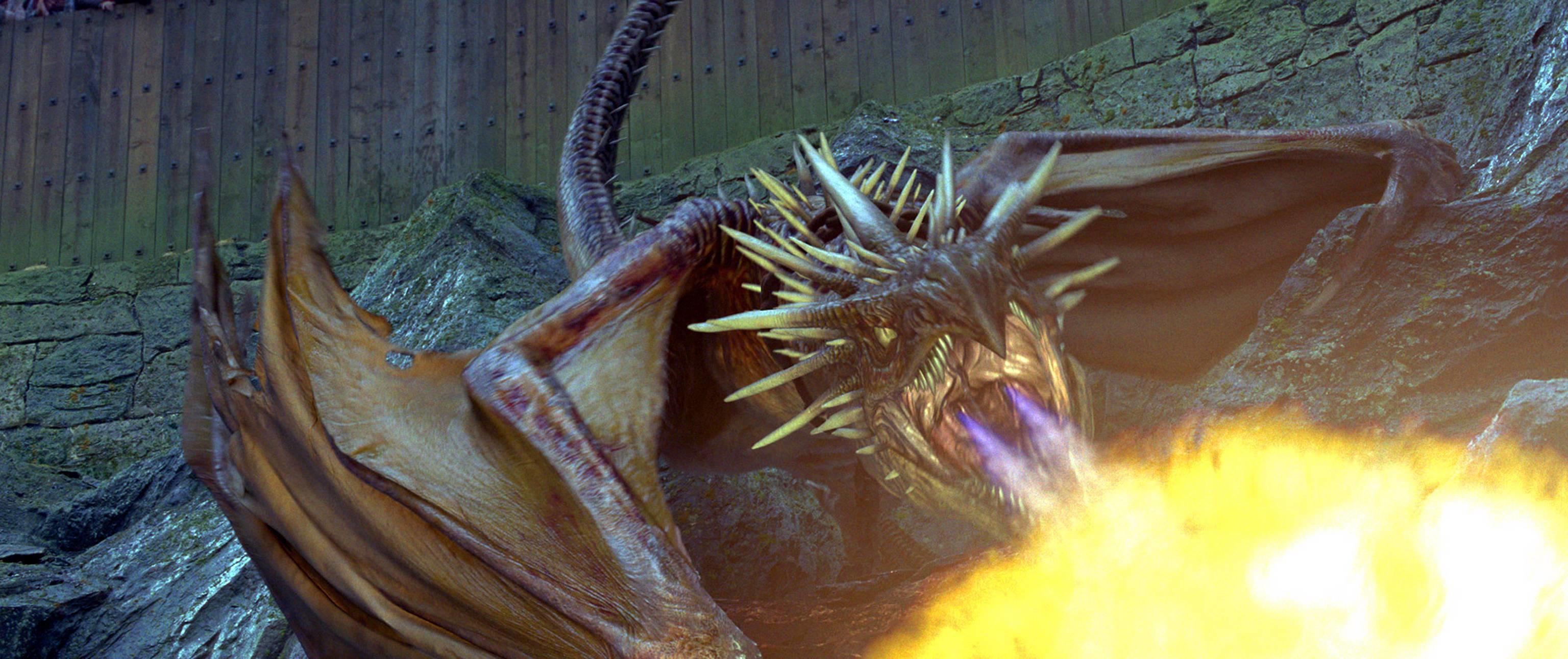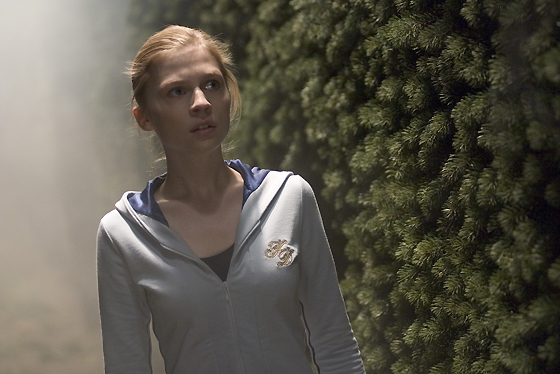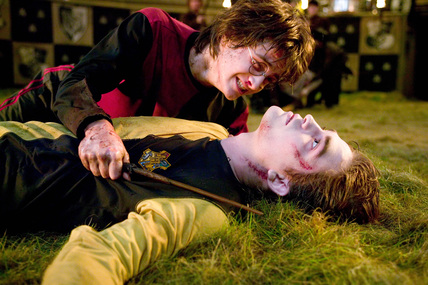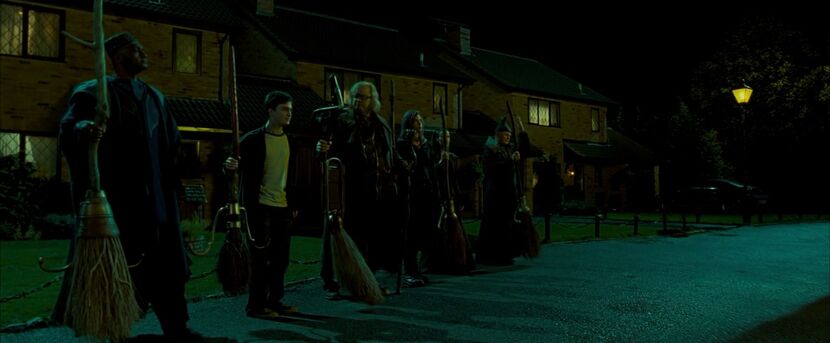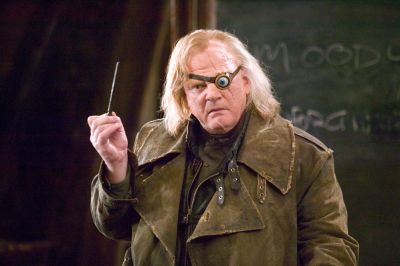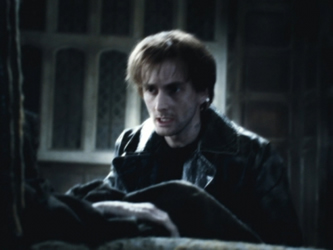The fourth Harry Potter book, Goblet of Fire, is the path of Temperance.
Here, Harry must complete a series of tasks in the Triwizard Tournament. He has no wish to enter this contest, as the stakes are high and the path is treacherous. But, the Grail (the Goblet of Fire) chooses him; he is compelled by fate and circumstance (and "a binding magical contract") to do so.
Dumbledore now took out his wand and tapped three times upon the top of the casket. The lid creaked slowly open. Dumbledore reached inside it and pulled out a large, roughly hewn wooden cup. It would have been entirely unremarkable had it not been full to the brim with dancing blue-white flames.
The Goblet of Fire itself is found inside a coffin, hinting, with true Masonic flair, at life from philosophic death.
Harry must, first of all, defeat the fire-breathing dragon. Before this task, Ron (Sulphur) has deserted him; his triumph over the dragon, at great personal risk (with the help of his trusty Firebolt broom--fight fire with fire), is the event by which he is also reunited with Ron, who once more becomes his faithful ally.
Harry's fellow contestant Fleur Delacour defeats the dragon by pouring water on it (Temperance). She will become more significant later.
In a typical instance of teenage melodrama, the boys of Hogwarts are compelled to find dates for the school dance--that is, Harry must now get in touch with his feminine side. But at this stage, no-one has the right partner.
Harry must then, conformable to the alchemical mythos, take the dragon's golden Philosopher's Egg and learn how to hatch it. The egg has various alchemical symbols on it. To open the egg and complete the next task, Harry must suffer an immersion in the Bath.
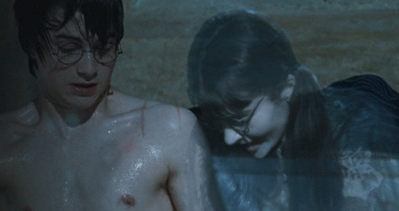 |
| "The wand chooses the wizard?" |
The Living Dead Girl, Moaning Myrtle (MM), again greets Harry here in the prefects' bathroom. (Room 217 in the Overlook?)
Harry must then descend into the unconscious to rescue his friends from a watery death. (It will be seen here that these tasks are meant to symbolize the entirety of the alchemical opus, as, indeed, does the Temperance card itself.)
In the third and final task, Harry must navigate a labyrinth and literally answer the Riddle of the Sphinx before finding the Grail, which, of course, is the same as the end of the second book.
His lower initiation having been completed, Harry now becomes an Adept and travels through a "Portkey," which corresponds to the "Portal" grade that leads to the Inner Order of the Golden Dawn.
The First Order Grades were related to the four elements of Earth, Air, Water, and Fire, respectively. The Aspirant to a Grade received instruction on the metaphysical meaning of each of these Elements and had to pass a written examination and demonstrate certain skills to receive admission to that Grade.
[Compare this to the yearly exams at Hogwarts--the Triwizard competition was originally designed to have four trials relating to the four elements, says Rowling.]
The Portal Grade was an "Invisible" or in-between grade separating the First Order from the Second Order.[36] The Circle of existing Adepts from the Second Order had to consent to allow an Aspirant to be initiated as an Adept and join the Second Order.
The Second Order was not, properly, part of the "Golden Dawn", but a separate Order in its own right, known as the R.R. et A.C. The Second Order directed the teachings of the First Order and was the governing force behind the First Order. ("Hermetic Order of the Golden Dawn")
But instead of attaining a quick and painless enlightenment, Harry here discovers firsthand that the Grail is full of poison. Voldemort has killed a woman named "Bertha"--i.e. Harry's "birth" is accompanied by an evil Shadow (as per Mother Monster). Harry instead "rebirths" Voldemort, infusing it with his own "blood" (libido energy).
Voldemort's rebirthing is on the grave of Tom Riddle (Christian Rosenkreuz)--i.e. the Vault of the Adepti, where Harry Potter becomes a member of the RR et AC. Tom Riddle is named after his father; i.e. he inherited Adam's derangement.
Under the guidance of MacGregor Mathers, the Vault of the Adepti became the initiation chamber of the Golden Dawn’s Second or Inner Order. The Adeptus Minor Ceremony is largely centered around the story of the discovery of the tomb of Christian Rosenkreutz. The Fama describes the Rosicrucian Vault as the Tomb of Christian Rosencreutz. . . . unlike Christ, CRC is not resurrected, although his body is perfectly preserved. His tomb is a tomb of Death.
And yet the opening of CRC’s tomb announces the rebirth of the mysterious Rosicrucian Brotherhood as portrayed in the Fama. Therefore the Vault is a symbol of death and spiritual resurrection.
In the Adeptus Minor Ceremony of the Golden Dawn, the officer known as the Chief Adept represents an Initiate who has undergone this alchemical process of self-transmutation and spiritual evolution. The Chief Adept, representing Christian Rosencreutz at one point in the ritual, tells the Aspirant:
"Buried with that Light in a mystical death, rising again in a mystical resurrection, cleansed and purified through Him our Master, O Brother of Cross and the Rose. Like Him, O Adepts of all ages, have ye toiled. Like Him have ye suffered tribulation. Poverty, torture and death have ye passed through. They have been but the purification of the Gold. In the alembic of thine heart, through the athanor of affliction, seek thou the true stone of the Wise."
In the Adeptus Minor Ceremony of the Golden Dawn the tomb of Christian Rosencreutz has another name: This place was entitled by our still more ancient Fratres and Sorores, the Tomb of Osiris Onnophris, the Justified One.
(Chic Cicero)
And yet the opening of CRC’s tomb announces the rebirth of the mysterious Rosicrucian Brotherhood as portrayed in the Fama. Therefore the Vault is a symbol of death and spiritual resurrection.
In the Adeptus Minor Ceremony of the Golden Dawn, the officer known as the Chief Adept represents an Initiate who has undergone this alchemical process of self-transmutation and spiritual evolution. The Chief Adept, representing Christian Rosencreutz at one point in the ritual, tells the Aspirant:
"Buried with that Light in a mystical death, rising again in a mystical resurrection, cleansed and purified through Him our Master, O Brother of Cross and the Rose. Like Him, O Adepts of all ages, have ye toiled. Like Him have ye suffered tribulation. Poverty, torture and death have ye passed through. They have been but the purification of the Gold. In the alembic of thine heart, through the athanor of affliction, seek thou the true stone of the Wise."
In the Adeptus Minor Ceremony of the Golden Dawn the tomb of Christian Rosencreutz has another name: This place was entitled by our still more ancient Fratres and Sorores, the Tomb of Osiris Onnophris, the Justified One.
(Chic Cicero)
The Voldemort homunculus is the Eraserhead child. The child of this union is noxious and repugnant, but it is Harry's and, like Sophia's abortion, he must see it through to its proper birth. There is no turning back.
The Death Eaters, Voldemort's loyal followers, are the Eyes Wide Shut masketeers. "Well imagine their surprise when the realize the Black Lodge is inside them!"
Voldemort claims his first new victim, Cedric Diggory, who represents the outgoing, healthy, and altogether normal personality that is irrevocably lost when the Shadow is revealed. His loss will be missed most of all, even if, it is admitted, he was not actually very bright (being unconscious of his darker half).
The Order of the Phoenix is composed of two real occultists: Aleister Crowley (Alastor Moody, middle) and Eliphas Levi (Elphias Doge, far right).
|
In the Potter series, many people are named after famous members of the Occult Revival, showing that Rowling does her homework. (Is literally everyone in on the joke? Fred and George Weasley are jokers.) Elphias Doge is obviously named after Eliphas Levi. Cassandra Vablatsky is H.P. Blavatsky. Harry spends a lot of time with Arthur Weasley--Arthur Waite?
Aleister Crowley and Alastor Moody
In Goblet of Fire we are also introduced to the character of Alastor Moody, who is quite clearly based upon Aleister Crowley. Moody has a "mad eye" (which again refers to the white and black Crowleys). Potter is all about the Father-imago--"Defence Against the Dark Arts" = DADA, and there's a new teacher (read: Hierophant, Le Pape) every year. They all express the principle of duality; Quirrell's shadow is Voldemort; Gilderoy Lockhart is an egotistical liar; Lupin is secretly a werewolf.
S.L. MacGregor Mathers and Bartemius Crouch, Sr.
Young Aleister Crowley and Bartemius Crouch, Jr.
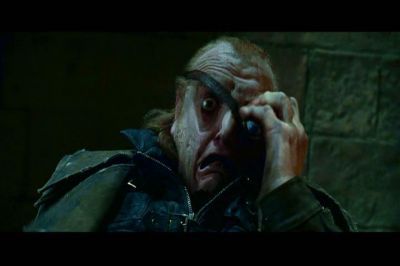 |
| The impostor Alastor is revealed. |
As I have mentioned before, there are, in effect, two Aleister Crowleys, as all of his writings operate on multiple levels of meaning. In their outer, exoteric sense, they are little more than a farrago of black magic and nonsense, but the sincere student will ascertain that the inner, esoteric doctrine of rebirth is hidden beneath the surface. (This is, additionally, a metaphor for the Potter books themselves, where magic[k] is used as a metaphor for inner alchemy.) The unmasking of the impostor Alastor Moody at the end of Goblet of Fire is merely a way of showing that Harry has now attained to the Greater Mystery--"the initiate is now passing from the Lesser Mysteries of the Outer Order of the GD to the Greater Mysteries of the Inner Order of the RC & AA." The "real" Moody is, appropriately enough, found at the bottom of a bewitched magical trunk with seven locks. (That is, the true doctrine of the Mysteries is guarded by seven veils.)
Having attained to the Second Order, Harry will now encounter the Dweller on the Threshold of the Abyss--this is the subject of the fifth book, The Order of the Phoenix. (The Order of the Phoenix represents the Invisible Chiefs of the 3rd Order--and includes in its ranks, of course, Crowley/Moody himself.)
“I learned that the world has a soul, and that whoever understands that soul can also understand the language of things. I learned that many alchemists realized their destinies, and wound up discovering the Soul of the World, the Philosopher’s Stone, and the Elixir of Life. But above all, I learned that these things are all so simple they could be written on the surface of an emerald.” The Alchemist by Paulo Coelho
Where ya headed Dorothy?
“All you have to do is contemplate a simple grain of sand, and you will see in it all the marvels of creation. Listen to your heart. It knows all things, because it came from the Soul of the World, and it will one day return there.” The Alchemist by Paulo Coelho
(I found the entire universe in this issue of the New Yorker)
“There is only one way to learn,” the alchemist answered. “It’s through action. Everything you need to know you have learned through your journey”
"You’ve got to find the treasure, so that everything you have learned along the way can make sense."
9/11 Glamour
9/11 Glamour
glamour |ˈglamər| (also glamor)nounthe attractive or exciting quality that makes certain people or things seem appealing or special : the glamour of Monte Carlo | [as adj. ] the glamour days of Old Hollywood.• beauty or charm that is sexually attractive : George had none of his brother's glamour.• archaic enchantment; magic : that maiden, made by glamour out of flowers.[Rebelle Fleur]ORIGIN early 18th cent. (originally Scots in the sense [enchantment, magic] ): alteration of grammar . Although grammar itself was not usedin this sense, the Latin word grammatica (from which it derives) was often used in the Middle Ages to mean [scholarship, learning,] including the occult practices popularly associated with learning.
"I Need to Open Up."
And as they did eat, Jesus took bread, and blessed, and brake it, and gave to them, and said,
Take, eat: this is my body.
It follows from these elucidations that the higher understanding of the Eucharist and the mystic side of alchemy are concerned with the same subject, that is to say, with man, his p. 547 conversion and transfiguration: the implicits are therefore the same, and of these things alchemy was the next witness in the world after the epoch of the Holy Graal. . . .
So, therefore, the Stone transmutes and the Eucharist transmutes also; the philosophical elements on the physical side go to the making of the Stone, which is also physical, and the sacramental elements to the generation of a new life in the soul. He who says Lapis Philosophorum says also: My beloved to me and I to him. Christ is therefore the Stone, and the Stone in adept humanity is the Union realised, while the Great Secret is that Christ must be manifested within. (Arthur Waite)





